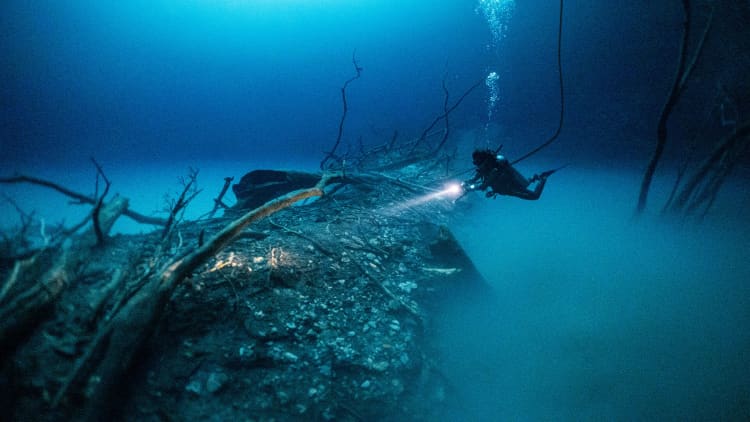
Submarine cables are the backbone of the Internet, carrying 99% of the world’s data traffic.
Serge Myshkovsky | CD | Getty Images
Tensions between the United States and China over technology have reached their lowest point.
Undersea cables made headlines earlier this year when four of 15 critical undersea cables in the Red Sea were severed following attacks on Israeli, American and British ships by Iran-backed Houthi rebels in Yemen.
As a result, public awareness of submarine cables has increased, and these cable networks are becoming a new source of tension in international relations at a time when geopolitical engagement between China and the United States is heating up.
What is a submarine cable?
According to telecom market research firm TeleGeometry, hundreds of giant telecom cables are buried deep underwater, with a length of nearly 1.4 million kilometers.
Some of these cables are shorter, such as the 131km-long CeltixConnect cable connecting Ireland and the UK. However, other cables run much longer distances, such as the 20,000 km Asia America Gateway cable.
The number of submarine cables worldwide is expected to increase in the coming years, reflecting growing demand for data traffic driven by the popularity of video streaming and cloud services.
TeleGeometry said its data tracked 574 active and planned submarine cables as of early 2024.
Why are they important?
Submarine cables are the backbone of the global Internet, carrying 99% of the world’s intercontinental data traffic.
“If you’ve emailed, texted or video chatted with someone on another continent, you’ve probably used undersea cables without hesitation,” Andy Champagne, chief technology officer at Akamai Labs, told CNBC via email.

Champagne added: “While we are connected by a complex network of physical fiber optic cables on land, once we drop into the ocean the topology becomes more challenging.”
“Installing subsea cables is really complex. And when something goes wrong with a subsea cable, fixing it is a huge undertaking.”
A key factor in why undersea cables are important is the impact they have when they are disrupted, said Joe Vaccaro, vice president and general manager at ThousandEyes, a network monitoring company owned by Cisco.
“As individuals like you and me, we don’t say that undersea cables are cut. We found that the applications we were trying to access suddenly became very slow or unavailable,” Vaccaro told CNBC.
“Ultimately, when these cuts happen, the underlying providers carrying that traffic have to try to dynamically shift the traffic to different routes,” Vaccaro added. “What happens when you do that? You see a certain degree of congestion occurs.”
Growing security risks
Submarine cables have traditionally been owned and operated by telecommunications operators. Recently, US tech giants including Meta, Google, Microsoft and Amazon have invested heavily in laying their own cables.

In 2021, Meta and Google announced plans to lay two giant undersea cables to connect the U.S. West Coast to Singapore and Indonesia. The Echo and Bifrost trans-Pacific cables are expected to increase data capacity between regions by 70% and improve network reliability.
Meta is investing in both cables, while Google is investing Only supports Echo. Meta previously announced plans to build a 37,000-kilometer undersea cable around Africa to provide it with better internet access, while Google is also developing an undersea cable called Equiano aimed at connecting Africa to Europe.
The Wall Street Journal reported in May, citing unnamed State Department sources, that U.S. officials were privately warning tech companies, including Google and Yuan Undersea cables in the Pacific could be vulnerable to espionage by Chinese maintenance ships.
SB Submarine Systems, a Chinese state-owned company that helps repair international cables, appears to have hidden the location of its ships from radio and satellite tracking systems, according to the Wall Street Journal.
SB Submarine Systems, Google, Meta and the State Department had no immediate comment when contacted by CNBC.
Meanwhile, Estonia said China had yet to respond to a six-month-old request to help it investigate a Chinese ship suspected of cutting two of its undersea cables. China’s Ministry of Foreign Affairs has since stated that it is ready to cooperate with Estonia in the investigation.
The developments highlight how underwater cables have become a source of contention as a national security issue. The information sent over these networks may involve high-risk communications, including coordination of diplomatic missions, security operations and intelligence gathering.
The U.S. government’s concerns are not new and have been widely documented.
In March 2023, Reuters reported that an interagency committee called Team Telecom was working to prevent any undersea cables from directly connecting U.S. territory to mainland China or Hong Kong due to concerns about Chinese espionage.
Many international undersea cable projects are reportedly bypassing China due to concerns about data security and Beijing’s expanding geopolitical influence. China has invested hundreds of millions of dollars in building its own underwater cable infrastructure to rival the United States
fragile center point
A key problem with the way submarine cables are currently set up is that the connections that connect them around the world impact large parts of the network infrastructure.
“If being able to provide connectivity between these two points in the world is critical to your business, then just realize that a single cable cut in that location could have a huge impact on every major cloud provider,” ThousandEye’s Vaccaro told CNBC.
When such critical connections experience outages, a “blame game” can ensue, with consumers often blaming the services they use when outages or traffic jams occur.
Vaccaro added that in some regions, it actually makes sense from a “performance and visibility” perspective for companies to use different cloud providers in different parts of the world to ensure consistent network quality.
Akamai’s Champagne said: “The key thing to remember with subsea cables is that there are specific requirements for the transition from subsea to land…and there are a limited number of geographies that meet those requirements.”
“The upshot of these limitations is that the loss of a single submarine cable can have a domino effect on the land networks that rely on it,” he added. “The impact of a disruption in a submarine cable is typically much greater than the loss of a land cable.”





